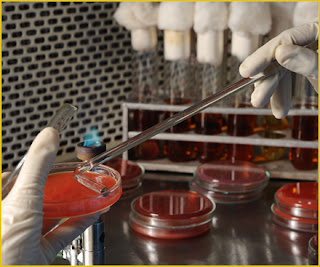
LAL TEST(Limulus Amebocyte Lysate):
Introduction:
Limulus Amebocyte Lysate(LAL) is an aqueous extract of blood cells ( amebocytes) from th horseshoe crab, Limulus polyphemus .In December 1987, the U.S Food and Drug Administration (FDA) published the Guidelines on the validation of the Limulus Amebocyte Lysate test as an end-point endotoxin test for human & animal parenteral drugs., biological products & medical devices. The LAL test for pyrogen in parenterals was first applied by Cooper et al . The LAL test was found to be more accurate & time saving than pyrogen test.
Definition:
LAL(Limulus Amebocyte
Lysate) Test is the most sensitive and specific means to detect and measure
endotoxin, a fever producing byproduct of
gram negative bacteria such as E.coli
and Pseudononas commonly known as
pyrogen. Endotoxin produces an opacity and
gelation in LAL. The simplicity and economy of the LAL test encourages the
testing of in- process solutions and raw materials, The LAL test is used as the
replacement for the rabbit pyrogen test.
Principle:
Proenzyme ----->
Endotoxin -----> Coagulase
Coagulagen ----->
Coagulase -----> Coagulin
Gram-negative bacterial
endotoxin catalyzes the activation of proenzyme in the Limulus Amebocyte
Lysate. The concentration of
endotoxin present is determine the initial rate of activation . The activatied enzyme ( Coagulase ) hydrolyzes specific
bonds within a clotting protein ( Coagulogen ) also present in Limulus Amebocyte
Lysate . Once hydrolyzed, the resultant coagulin
self associates and forms a getatinous
clot .
 Methods of Lat Test:
Methods of Lat Test:
There are five methods of LAL test:
1) Gelation
Method : Limit Test
2) Semi
quantitative Getation Method
3) Turbidimetric Kinetic Method
4) Chromogenic
peptide Kinetic Method
5) Chromogenic
peptide endpoint Method .
Gelation Method:
The Gelation or Gel–Clot LAL
test Method is a simple reproducible
test that is conducted by mixing equal parts of Endosafe. LAL reagent and test
specimen and promptly incubating the mixture in disturbed for 60 minutes at 37
°C . A positive response indicates that there is an amount of endotoxin in the
sample which equals or exceeds the reagents labeled sensitivity.
Test Procedure :
1) Add 0.1 ml
/0.25 ml of each dilution to the assay tube ; test at least in duplicate.
2) Add 0.1ml
/0.25 ml of reconstituted standard to each tube starting with the – ve control
& ending with the highest endotoxin concentration.
3) Place the
reaction tube in a 37°C water or dry bath for 60 ± 2minutes
4) Observe the
tubes for Gelatin . If gel is formed which retains after turning the tubes to
180°C, then the test is +ve for endotoxin . And if the gelation does not
take place, the test is – ve for
endotoxin presence.
Conclusion:
As
LAL is capable of detecting a very minute amount of endotoxin in product, hence
it is now widely accepted throughout the world
in instead Pyrogen test.

No comments:
Post a Comment